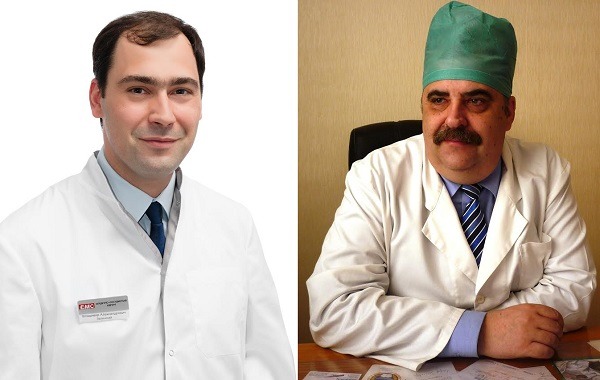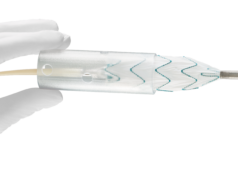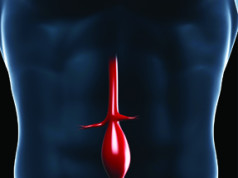
The prevalence of abdominal aortic aneurysms in patients over 55 vary between 4% and 7.2%, depending on age, gender and geographic location. The innovative approaches of the last decades in the development of diagnostic tools and surgical management have led to significantly improved outcomes in these patients. However, late verification of intact aneurysms is common, while the incidence of ruptured aneurysms ranges from 5.6 to 17.5 per 100,000 person-years in western countries. The overall mortality rate of patients is still extremely high at approximately 80–90%, and operative mortality rates for ruptured aneurysms still ranges from 32% to 80%.
Significant improvements in outcomes for abdominal aortic aneurysm patients seem impossible without early verification and influence of aneurysm progression. Screening programmes are based on early morphological detection of aneurysms, which reduces the potential for study of pathogenesis and possible target points for drugs therapy. Also, the benefit of early aneurysm diagnosis is limited because most are too small for intervention at the time of diagnosis.
In addition, effective tools to assess the risk of rupture still have not been developed. The natural history of abdominal aortic aneurysms relates to aneurysm diameter—widely accepted as a surrogate marker of the aneurysm growth rate and of the risk of rupture. Thus, the majority of researchers have agreed that 5cm is the critical maximum aneurysm diameter at which the risk of rupture increases significantly. However, several cohort studies have shown that the small aneurysms with diameter less than 5cm could be also complicated cases. At the same time, several reports have demonstrated that large diameters (larger than 5cm) may progress for a long time without rupturing.
Consequently, one of the essential components of improving outcomes in abdominal aortic aneurysm patients will be the detection of the specific aneurysm serum markers in order to develop appropriate and effective risk assessment tools.
Despite significant progress in the development of algorithms for early detection and prevention of cardiovascular diseases and their complications, the problem of early aneurysm diagnosis and detection of predictive biomarkers for rupture remains. This is primarily due to the fact that most aneurysms remain asymptomatic, increasing in size steadily well until development of life-threatening conditions, ie. rupture, aortic outburst, thromboembolic events or the compression of surrounding tissues. Therefore, the development and implementation of effective biomarker screening programmes and aneurysm analysis via serum substance measurement need to be advanced. These programmes may clarify the incidence of aneurysms in the general population, detect the high-risk rupture subpopulation and provide evidence for target therapies. Although aneurysm pathogenesis are not understood, recent studies have found correlation between the risk of aneurysm rupture and the presence of certain circulating serum biomarkers. Some play crucial roles in inflammatory reactions within altered aortic walls, while others are catalysts for these reactions or are themselves fragments of destroyed aortic wall. In recent decades, a number of definitions for the term “biomarker” have been proposed, but all share the central emphasis: a countable substance/process in the human body that can affect the course of disease or may play a role as independent specific disease predictor.
The first reports of close correlation between certain serum substances and abdominal aortic aneurysms in the literature were produced in the late 1980s. In recent decades there have been a number of reports describing the sensitivity, specificity and cost-effectiveness of optimal circulating serum markers and their predictive value. All described biomarkers can be generally divided into several groups: fragments of degraded aortic wall, concentrations of enzymes catalysing the biochemical reactions of aortic wall protein matrix syntheses, and inflammatory biomarkers.
Aortic wall fragments
The following biomarkers in this group are considered to be the most informative predictors: elastin degradation fragments (serum elastin peptide and its derivatives), collagen metabolites (serum terminal propeptide of collagen type III), osteoprotegerin that is produced by smooth muscle cells and macrophages of aortic wall, and myosin heavy chains.
Enzymes in the aortic wall
There are several proteases in aortic wall that are involved in the aortic wall degradation process by means of their proteolytic activity or apoptosis activation. Their activity is regulated with a variety of inhibitors and activators that can potentially serve as targets for pharmacologic agents. Among these, matrix metalloproteinases (MMPs) are of the most pathogenetic importance, and are actively involved in the process of elastin degradation. Macrophages, neutrophiles and smooth muscle cells secrete MMP as an inflammatory response. There are several groups of MMP that are involved in aneurysm pathogenesis: collagenases (matrix metalloproteinases: 1, 5, 8, 13), gelatinases (matrix metalloproteinases: 2, 9, 12) and stromelysins (matrix metalloproteinases: 3, 7). Moreover, practical interest provides the substances that can activate or inhibit the secretion of these enzymes (proinflammatory cytokines, matrix metalloproteinase tissue inhibitors). In addition, the role of the other highly informative proteases should not be ignored (eg. elastases and cathepsins), as they participate in aneurysm aortic wall degradation without activation of MMP. Some researchers believe that activity of the cystatine C enzyme involved in the regulation of the activity of elastases could be one such biomarker.
Inflammatory biomarkers
Inflammatory response is considered to be one of the important concomitant processes in the pathogenesis of abdominal aortic aneurysms, and it seems to be logical to detect specific markers of the highest sensitivity and specificity for reflect inflammation within aortic wall. A large number of specific markers have been proposed in last decade. The inflammation biomarkers reflect different stages of immune response (cytokines/chemokines concentration [interleukine 1, 6], tumour necrosis factor activity, interferon gamma concentration, concentrations of C-reactive protein and fibrinogen, concentration of antibodies to chlamydophila pneumonia and herpes simplex virus). The main disadvantage of inflammatory biomarkers is their low specificity and sensitivity, which significantly reduces diagnostic and predictive value.
Proposed screening scheme
The pathological disorders of the aortic wall lead to aortic aneurysm transformation, resulting in increased aortic diameter. This stage of aortic disease is usually referred to as the preclinical stage or stage of normal aortic size. There are only a few reports that have tried to demonstrate a pathophysiology reaction of aortic wall disorders in the preclinical stage, and their results are fragmented and controversial. However, the analysis of the available literature and the results of our pilot studies allows us to distinguish three pathogenetic phases:
- Initiation of the inflammatory reactions
- Realisation of the activity of proteases
- Degradation of the aortic wall structure accompanied by smooth muscle cell apoptosis.
Apparently, the high activity value of certain circulating serum biomarkers relates to a specific preclinical phase, and that should be taken into account when developing a preclinical screening programme.
On the basis of current evidence from available articles related to biomarkers and history of abdominal aortic aneurysm, we have indicated the three groups of subjects who should undergo preclinical diagnostics:
- Children between 5 and 10 years old (to exclude hereditary predisposition factors)
- Subjects who are immediate relatives of abdominal aortic aneurysm patients
- Individuals older than 50 years.
Taking into account the fact that the preclinical phase of the disease is multi-staged, dividing the screening programme into several steps according to the outcomes of prior stages seems worthwhile:
- Phase 1: evaluation of enzymes participating in synthesis and catabolism of structural aortic wall components (primarily, the measurement of MMPs and cysteine C activity) and inflammatory markers. In the case of positive results, the programme should proceed to the second phase.
- Phase 2: detection of structural aortic wall components or cells metabolic products (osteoprotegerin, myosin heavy chains, serum elastin peptide). In case of positive results, the programme should proceed to the third phase.
- Phase 3: instrumental imaging of the aorta (ultrasound, computed tomography, positron emission tomography), followed by annual monitoring of this group.
The proposed screening programme is one of possible ways to detect high-risk individuals. It has some disadvantages and limitations (eg. sensitivity and specificity of the methods are not high and examinations are costly) and thus requires further investigation. However, the implementation of biomarker screening would allow detection of a more specific group of subjects with high risk of aneurysm manifestation and progression and would have a considerable positive impact in identifying therapy and new preventative programmes.
Vladimir Zelinskiy is at EMS (United Medical Systems), St Petersburg, Russia. Mihail Melnikov is at North-Western State Medical University (named after II Mechnikov), St Petersburg, Russia
References
- Urbonavicius S, Urbonaviciene G, Honoré B, et al. Eur J Vasc Endovasc Surg 2008; 36(3): 273–80.
- Moll FL, Powell JT, Fraedrich G, et al. Eur J Vasc Endovasc Surg 2011; 41 Suppl 1: S1–S58.
- Moris DN, Georgopoulos SE. Int Angiol 2013; 32 (3): 266–80.
- Bylund D, Henriksson AE. Am J Cardiovasc Dis 2015; 5 (3): 140–5.
- Folsom AR, Yao L, Alonso A, et al. Circulation 2015; 132 (7): 578–85.
- Wanhainen A, Mani K, Golledge J. Arterioscler Thromb Vasc Biol 2016; 36 (2): 236–44.













